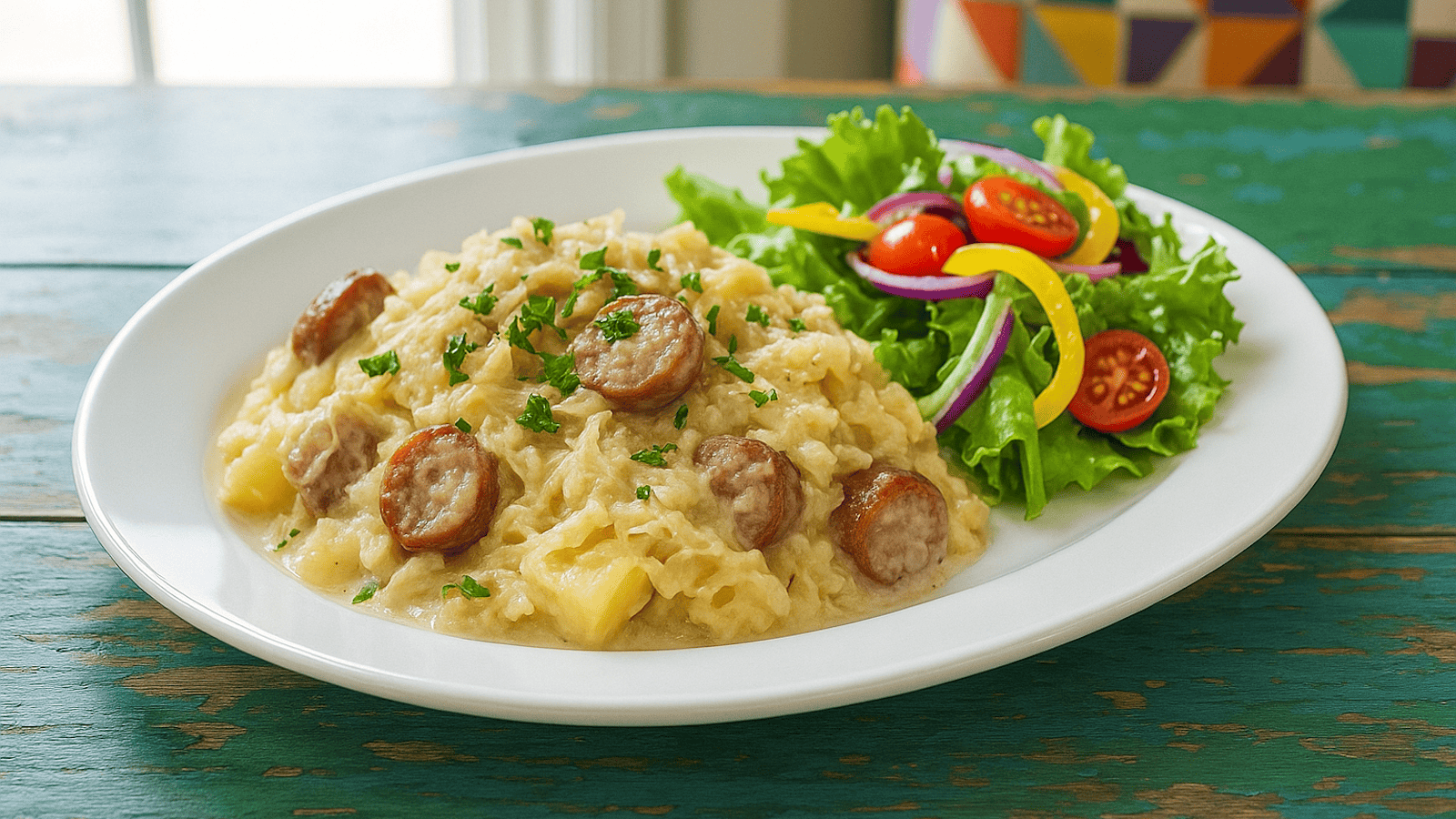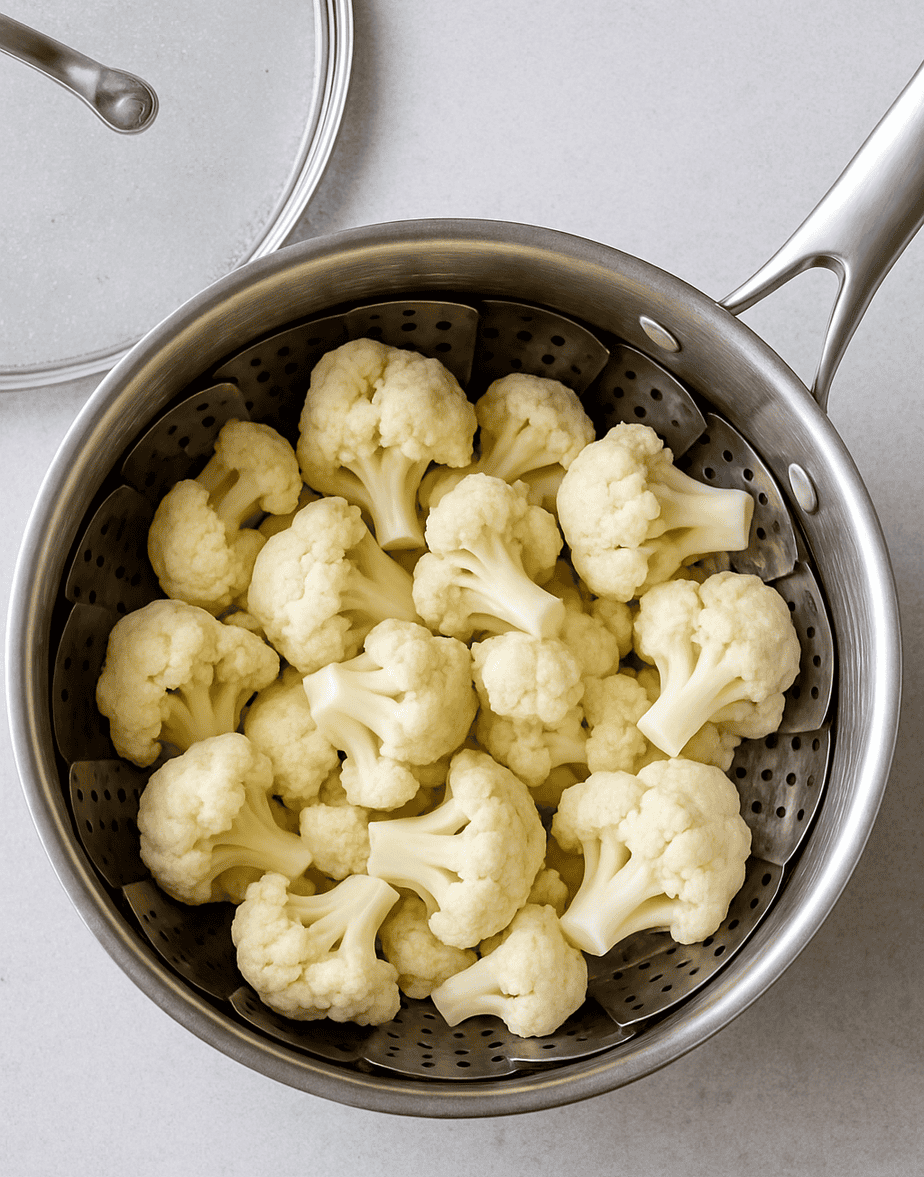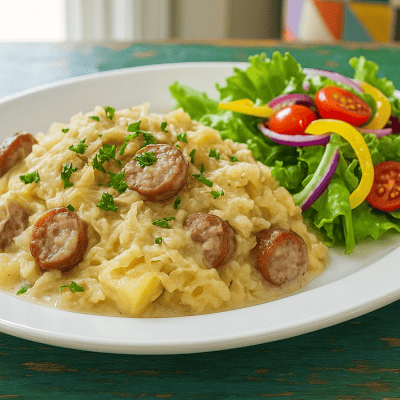Traditional versions lean heavy on cream, cheese, and refined ingredients, so I reworked the classic with a silky cauliflower sauce and clean-label sausage. The result is bold, hearty flavor with nourishing, gut-healthy benefits.
Years ago, during a trip to the charming Bavarian-style village of Leavenworth, Washington, I was surrounded by tempting German fare I couldn’t partake in. My husband indulged in something creamy while I made do with roasted chicken and a simple salad. My gut thanked me, but my taste buds were not impressed. That memory nudged me to recreate the flavors I love in a way that honors my body — and this casserole does exactly that.
So whether you eat or drink, or whatever you do, do all to the glory of God. (1 Corinthians 10:31 NIV)
Choosing clean, simple ingredients lets comfort food honor the body God designed.
My husband loves brats, kielbasa, and all kinds of sausages, but finding truly clean options is difficult. When he spotted fresh Kirkland Signature Original Bratwurst with no preservatives, no artificial flavors, colors, MSG, or gluten, we gave them a try. They were great, and this Bratwurst Sauerkraut Casserole was born. If you can find a sausage from grass-fed or heritage pork without sugar or “natural flavors,” even better.
Ingredient Highlights
-
- Bratwurst: The Kirkland brand bratwurst delivers authentic German flavor without the usual additives. While it contains dextrose, sugar, and natural flavors, it’s much cleaner than most store-bought sausages. For an even better option, look for grass-fed beef sausage with a truly minimal ingredient list—just meat, spices, and salt.
- Cauliflower: Forms the base of a creamy, dairy-free sauce that adds body and richness without heaviness. Cauliflower is naturally high in vitamin C, fiber, and sulfur compounds that support detoxification and gut health.
- Spicy Brown Mustard: Brings a tangy zip to balance the dish while supporting digestion. Mustard seeds contain beneficial plant phytonutrients that may aid liver detox pathways.
- Potatoes: Comforting and naturally gluten-free, they provide satisfying complex carbohydrates and a good dose of potassium for electrolyte balance.
- Sauerkraut: Adds brightness and tang to balance the richness of the sausage. Traditional fermented sauerkraut (found in the refrigerated section) contains live probiotics that support gut health, while canned sauerkraut has been pasteurized and no longer contains living cultures. Although baking the casserole destroys most probiotics, heat-stable postbiotic compounds—like organic acids that support digestion—remain.
If you’re new to cooking without dairy or gluten, check out these posts:
How to Make Bratwurst Sauerkraut Casserole
- Steam the cauliflower until tender.
- Sauté the sausage and potatoes in a small Dutch oven until golden.
- Blend the creamy cauliflower sauce ingredients.
- Stir the sauce and sauerkraut into the sausage and potatoes.
- Cover and bake for 35 minutes; uncover and bake for another 10 minutes until the potatoes are fork-tender.
FAQs
What’s the best side dish for this casserole?
Broiled tomatoes or a simple green salad with olive oil and lemon. The fresh, bright flavors complement the richness of the casserole.
What kind of sauerkraut works best?
Choose a fresh, refrigerated sauerkraut made only with cabbage and salt—no vinegar or added sugar. It tastes cleaner and retains more beneficial nutrients than canned, pasteurized options.
Can I use another type of sausage?
Yes. Kielbasa is a great alternative if you find a clean, preservative-free version. It complements the other ingredients with robust, savory flavor.
How can I make this ahead or reheat leftovers?
Assemble up to 24 hours in advance, cover, and refrigerate. Bake from cold, adding 5–10 minutes. Reheat leftovers covered at 325°F until hot, or gently on the stovetop with a splash of broth.
Are gluten-free pretzels a good topping?
We tried adding chopped gluten-free pretzels in the last 10 minutes of baking, but they softened. For crunch, broil briefly at the end or add just before serving. We prefer the casserole without them.
Ready for some cozy, fall-inspired German comfort food? Gather your favorite clean bratwurst, a jar of real sauerkraut, and get in the kitchen—this casserole is simple, satisfying, and sure to warm up your table.
If you give it a try, please share your thoughts in the comments, print the recipe for later, or pin it to share the comfort with others.
Dairy-Free, Gluten-Free Bratwurst Sauerkraut Casserole
Ingredients
- 1/2 small head cauliflower, , cut in ~1.5-inch pieces
- 1 tablespoon avocado oil
- 3 bratwursts, , sliced 1/4-inch thick
- 2 medium russet potatoes, , sliced 1/4-inch thick
- 1/2 cup chicken bone broth
- 1 tablespoon nutritional yeast
- 1/2 tablespoon spicy brown mustard, (other prepared mustard or 1/2 teaspoon dry mustard will also work)
- 1 teaspoon garlic powder
- 1 teaspoon onion powder
- Ground black pepper, , to taste
- 1 cup sauerkraut, , drained
- 2 tablespoons chopped fresh parsley, (optional)
Instructions
- Preheat oven to 350F.
- Steam the cauliflower for 8 to 10 minutes until soft. Allow it to cool while you brown the bratwurst and start the potatoes.
- In an oven-proof Dutch oven, heat the oil over medium-high heat until hot, but not smoking. Add the sausage and cook, stirring frequently, for about 3 minutes until it starts to brown evenly. Add the potatoes and sauté for 5 to 7 minutes, stirring occasionally, until they look glossy and a bit golden on the edges.
- Transfer the cauliflower to a blender. Add the broth, nutritional yeast, mustard, garlic powder and onion powder. Blend until smooth. Taste and season with pepper, if desired.
- Pour the sauce into the Dutch oven. Add the sauerkraut and stir to thoroughly combine.
- Cover and bake for 35 minutes until the potatoes yield easily to a fork.
- Bake another 10 minutes or so until the potatoes in the center are fork-tender.
- Remove from the oven and let stand 10 minutes before serving. Serve garnished with parsley, if desired.
- Store leftovers in the fridge for up to 4 days or the freezer up to 3 months.


